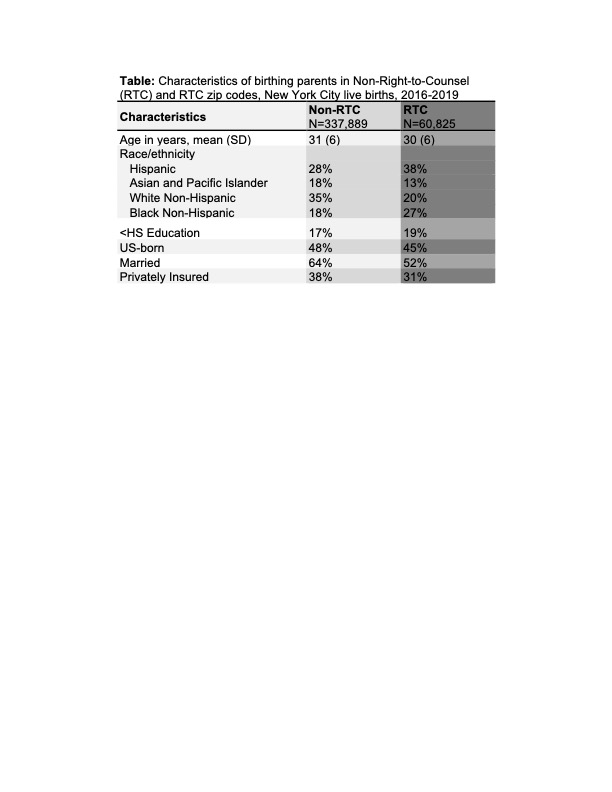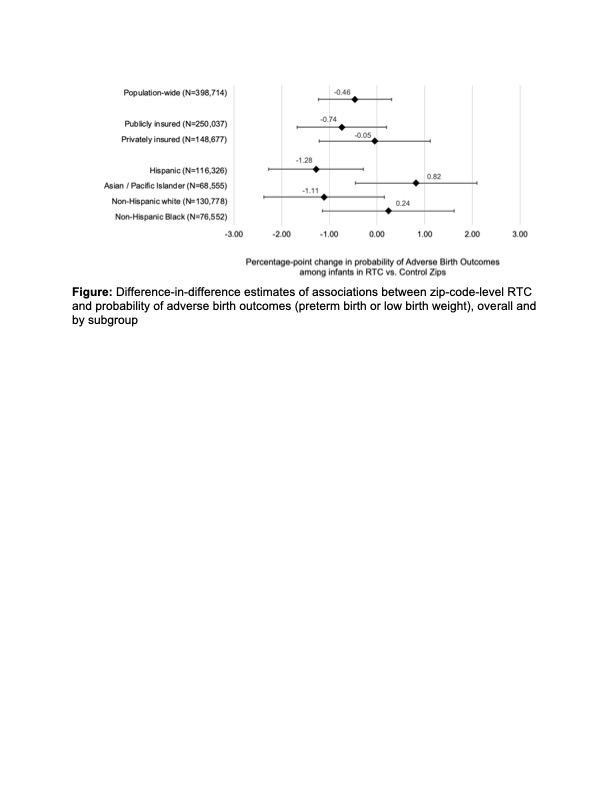Health Equity/Social Determinants of Health
Health Equity/Social Determinants of Health 4
437 - Tenant right-to-counsel in New York City: Impact on adverse birth outcomes
Publication Number: 437.219
- KL
Kathryn M. Leifheit, PhD MSPH (she/her/hers)
Assistant Professor, Pediatrics
University of California, Los Angeles David Geffen School of Medicine
Los Angeles, California, United States
Presenting Author(s)
Background: In the context of the US housing crisis, residential evictions are common and disproportionately affect renters of color. Evictions during pregnancy have been linked to an increased risk of adverse birth outcomes such as preterm birth and low birthweight. In 2017, New York City launched the United States’ first right-to-counsel (RTC) program by guaranteeing lawyers to low-income tenants facing eviction in select zip codes. The program has been successful in reducing eviction rates and may have positive spillovers on population health and health equity.
Objective: To 1) measure associations between zip code-level RTC implementation and risk of adverse birth outcomes (preterm birth and adverse birth outcomes) and 2) determine if associations varied across subgroups defined by birthing parents’ race/ethnicity and income.
Design/Methods: We leveraged the staggered rollout of RTC as a natural experiment to measure the program’s impact on adverse birth outcomes. We measured our outcome (a composite, dichotomous indicator of < 2500 grams or < 37 weeks gestation at birth) using individual birth certificate data from New York City Vital Statistics for all live births from 2016-19. Our exposure was RTC status in the infant’s zip-month of conception. We conducted a difference-in-difference analysis using linear probability models with fixed effects for year, month, and zip code, and clustered standard errors. We then stratified these models by maternal insurance type (public or private) and race/ethnicity.
Results:
Results: Data included 337,889 infants conceived in non-RTC zip codes and 60,825 infants in RTC zip codes. Relative to those in non-RTC zip codes, birthing parents of infants in RTC zip codes had lower socioeconomic status, were more likely to be born outside of the US, and were more likely to be non-Hispanic Black or Hispanic/Latino. Exposure to RTC during pregnancy was associated with a non-statistically significant change in infants’ probability of adverse birth outcomes (-0.46 percentage points; 95% CI -1.23, 0.30). This association was most pronounced among publicly insured birthing parents (-0.74, 95% CI -1.67, 0.20), Hispanic birthing parents (-1.28, 95% CI -2.27, - 0.29), and non-Hispanic white birthing parents (-1.11, 95% CI -2.37, 0.15).
Conclusion(s):
RTC was marginally associated with improved birth outcomes at the population level. The magnitude of associations varied substantially across population subgroups. Further research is needed to understand RTC’s potential as a population intervention to improve birth outcomes and promote child health equity.

